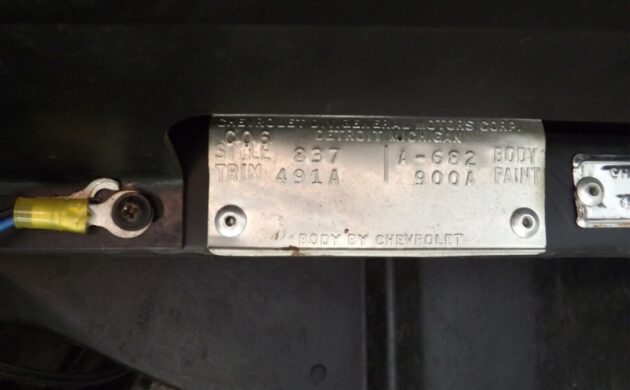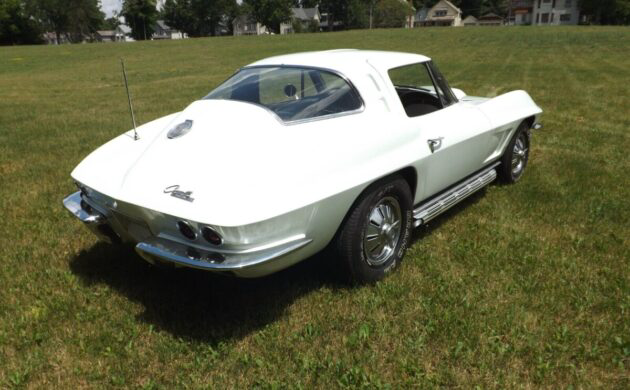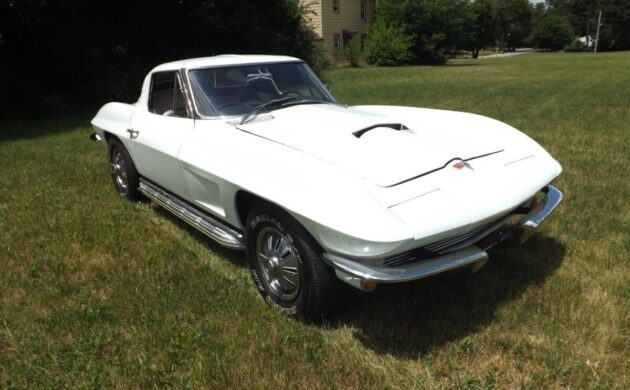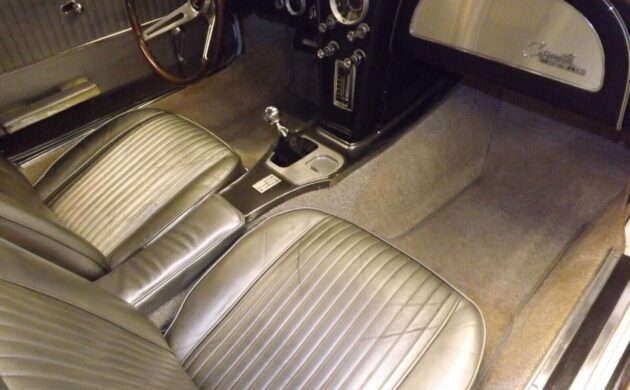There are two types of Corvette people: those who worship at the altar of originality and those who customize the cars to make them their own. The person who cobbled together this 1964 Corvette coupe for sale on eBay out of Galion, Ohio certainly knew what they wanted. With non-original side pipes, a later mode hood, and a change in paint color, this Corvette is not as it left the factory. Do these modifications reduce the desirability of a relatively solid but unremarkable base car? With bidding currently at $39,850 and climbing, can the argument be made that tasteful and period correct changes can enhance a car’s value?
Let’s start by decoding the trim plate. Style 837 designates the car as a coupe. Trim 491A is for two tone grey and silver vinyl interior. Body A-682 tells us that the body was produced by A. O. Smith. Finally, paint code 900 represents Tuxedo Black. Bear in mind that a lot of Corvettes have had their trim tags replaced, either because they were stolen, or the owner decided to switch it with a change in exterior color. You can still get these reproduced today and only a couple of rivets hold them on.
A quick look at the pictures makes me think this Corvette isn’t black anymore. The 1967 style hood doesn’t seem to match what should be on the car either. The final out of place element is the side pipes. The seller tells us that the car didn’t come from the factory with these either. Chevrolet should have made them standard on every C2. They just look and sound so good.
Still, the car presents well. At least it looks good from the slightly overexposed pictures we have to work with. It seems that a very white car doesn’t photograph well in full sunlight. The seller does provide a number of chassis pictures that show the car is in good condition, free of rust, and has no obvious accident damage. The raised white letter Grand AM tires should probably be replaced before the neighbors think ill of you.
In the picture above, the hood stands out not only for being incorrect, but also for having a very poor fit. The tall K&N air filter is probably causing that problem along with some sloppy fitting when it was installed. The gap in the front really stands out. There may be some issue with the hidden headlights as well. These do have adjustments to make them sit properly when closed.
The nicest part of this car is the interior. The carpets, door panels, and seats all appear to be either new or well taken care of. Carpet sets on these cars can be a pain to fit, especially on older C2s, as I believe these cars had more pieces than later cars. Perhaps the art of molding carpets to complex shapes improved as time went along. The picture also seems to show an actual wood steering wheel unless the imitation woodgraining on this car’s wheel is perfect. It just looks too good in the picture, and adding a wooden wheel is popular among C2 owners. Nobody likes plastic.
The seller tells us that this car was probably an L79, which is a theory he bases on the tachometer (redline) and the oil pressure gauge. This may be a typo, as he tells us the engine number and that the pad suffix is RD. RD should designate it as an L75 300-horsepower engine with a manual transmission. While the photo above shows the engine in the car, it appears that a number of items are not stock for that year. There is one thing that appears to be original, and that is the single pot brake master cylinder. This is one item that I would prefer to have updated if this were my car.
Looking at the car as a whole, you come to the conclusion that this would be a Corvette to drive and enjoy. It could be restored to NCRS standards if you were willing to search out all of the date code correct original parts and pieces. For a low horsepower 1964 car that would probably be more trouble than it is worth. With a little work this car could be a local show queen, and there is nothing wrong with that at all.
What would you do with this semi-correct 1964 Corvette?









Originally being black makes this a pretty desirable car, especially with the silver interior. It’s a shame the original motor appears to be gone, and the body looks a little rough. The fit of the hood (a 67 big block one), and the headlights (especially the right) is terrible, and the 64 two side fender louvers have been cut out and turned into a single large one. Someone wanting to restore this to it’s original black, may want to consider replacing the nose. With that in mind, if the price doesn’t go much higher, this may be a nice car for someone.
The steering wheel is the standard 64 walnut grain plastic wheel, not a real wood wheel.
40 Large for this? Guess the big bucks are out there. I’d get a decent paint job on it and drive as is. U guys think its worth it? This ol grey hair is out of touch. Pricing is out of reach for joe six pack that always wanted a ‘Vette.
Cheers anyway
GPC
Over all, the car looks half way decent. The interior’s nice, and it may not be the original engine, but if it is a date correct 64, that’s a plus. Even if you have to hang a full nose on this car, stripped and painted you’d probably have another $20K in it. 64’s are the least desirable of 63-67 Corvettes, so to have $60K in a 64 coupe you may be upside down a little, but for a black and silver one, you wouldn’t be to far off.
After looking at the pictures again, I realized this car appears to have 63 coupe doors on it. 63 doors have a wide stainless molding on the a-pillar, while 64-67 doors have a painted, body colored a-pillars. 63 doors are quite valuable, you might be able to sell those doors, buy a pair of 64-67 doors, and have money left over to buy a $1500 one piece replacement nose?
I’m not sure but what it’s a ’63 body with a one piece back window. Look at the roof vents.
I am wondering if this car is a “bitsa”. Wrong doors , replacement engine, modified nose may or may not be an indication. What makes me more curious is the VIN plate. Looking carefully, beside the trim tag, only a small portion of the VIN plate is visible. The VIN plates on most ’63 and ’64 Corvettes were actually spot-welded on. It looks to me like this one was likely originally welded, but later has been re-attached with rivets. Some welds legitimately failed, and rivets were used, so this may, or may not be proof of VIN tampering/switching. This would however cause me to go to the trouble of comparing the VIN on the frame to the plate. It may also be that the engine is actually original, but the VIN plate is from another car.
It is a fact that over the years, a significant number of Corvettes were stolen, or assembled from wrecks, with stolen parts.
Literally thousands of questionable cars have been in circulation for decades. Most pass a cursory inspection. They tend to be identified when there is a thorough (expert) inspection; typically a pre-purchase inspection, insurance claim, or as part of a police investigation. Once identified, they Will be impounded, sometimes after decades and multiple owners. Current owners may not be charged, but there is often no recourse.
These were once cheap cars. Now they are not. It is always worth confirming the VIN and history before investing time and money.
40K and all that work?
I’d buy a C7 with 60K miles needing nothing but a driver. There out there if you’re patient.
They could easily increase the value of this car by removing the hood and leaving it off. Gauche!
That very well may be a ’63 coupe with the updated rear window that was a craze in the mid to late ’60’s. The vents in the B pillar are 1963 not 1964 and nobody would backdate those.
So it’s quite possible that this 63 coupe was updated to look like a ’64 sometime in its tough life and had a 1964 ID plate riveted in pace to make it appear to be a ’64.
Definatally a car to stay away from, too many questionable things. Especially the pop riveted vin tag!
40k for this turd?
Since ’63 coupes are worth a fortune, the interested parties are probably considering putting the post back in the rear window and putting a ’63 ID tag on it and making it into a big $ machine….
There was a body shop in Ohio doing this swap on 64’s.
KC, I think you mean ’63’s which were the only “Vettes with split window. Removing the split to make them look “more modern was a fad in the mid to late 60’s.